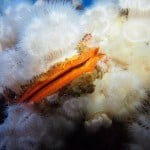Oil Rig Diving Information
 There are plenty of offshore oil rigs along the coast of California and the few you can dive can be quite an awesome experience.
There are plenty of offshore oil rigs along the coast of California and the few you can dive can be quite an awesome experience.
Some are decommissioned, but most are still in active operation. Some of these rigs are in deep water; their support structures rising from depths of 700 feet or more. The oil rig pillars and cross beams act as an open water oasis. making a home for reef & wall critters, and a resting/feeding stop for open ocean species. They make excellent artificial reefs.
Some of these rigs allow dive boats to bring out scuba divers to explore the bits of life that now call the support structure home. A few of the rigs that can be currently visited by divers are Eureka, Ellen, and Elley off the coast of Long Beach. Divers used to be able to visit Grace out of Ventura Harbor, but it has been off-limits to divers since mid-2008. Remember to be careful and responsible while out diving the oil rigs-any accident could cause a rig to be shut down to divers, losing a valuable diving resource.
Oil platforms are busy, privately owned workstations. Sometimes permission to dive them must be obtained well in advance from the oil company that owns them. Luckily this is not the case for the three rigs available to divers-Elly, Ellen, and Eureka.
Rigs make incredible offshore artificial reefs to learn more, please check out California Artificial Reefs and Rigs to Reefs
You can also view a map of California Oil Rigs, courtesy of California Artificial Reefs Enhancement Program, and a listing of what company owns which rigs along the California coastline, courtesy of Bureau of Ocean Energy Management (BOEM)
Grace oil rig
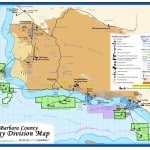 Oil Platform Grace sits 10.5 miles off the coast of Ventura, California near Santa Cruz Island. Grace was installed in 1979 and sits in 320’ of water. The legs and cross braces of Grace (or any other oil rig) underwater are used as a home to an incredible amount and variety of sea life.
Oil Platform Grace sits 10.5 miles off the coast of Ventura, California near Santa Cruz Island. Grace was installed in 1979 and sits in 320’ of water. The legs and cross braces of Grace (or any other oil rig) underwater are used as a home to an incredible amount and variety of sea life.
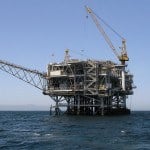 There are anemones of all colors, shapes, and sizes as well as sponges, crabs, starfish, nudibranchs, scallops, and much more. Schools of fish hang out under the structure as well as some sea lions that use the platform as a home. Grace is currently owned and operated by Veneco.
There are anemones of all colors, shapes, and sizes as well as sponges, crabs, starfish, nudibranchs, scallops, and much more. Schools of fish hang out under the structure as well as some sea lions that use the platform as a home. Grace is currently owned and operated by Veneco.
Eureka, Elly, and Ellen oil rigs
 Platforms Eureka, Elly, and Ellen sit in federal waters 8 ½ miles offshore from the Los Angeles area. Eureka is the deepest rig accessible to divers with it sitting in 720’. Elly and Ellen are unusual because they are a double platform with a bridge connecting them together. They sit in about 260’ of water which is still plenty deep for recreational or tech divers.
Platforms Eureka, Elly, and Ellen sit in federal waters 8 ½ miles offshore from the Los Angeles area. Eureka is the deepest rig accessible to divers with it sitting in 720’. Elly and Ellen are unusual because they are a double platform with a bridge connecting them together. They sit in about 260’ of water which is still plenty deep for recreational or tech divers.
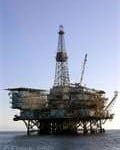 The platform on the left (Platform Ellen) is a drilling platform originally equipped with two drilling rigs and 80 well slots. The well slots are the individual pipes that are located within the center of the rig running down to the seafloor and are located within a well bay. Of the 80 there are many well bays and not all are used. The platform was installed in 1980 and drilling began in early 1981.
The platform on the left (Platform Ellen) is a drilling platform originally equipped with two drilling rigs and 80 well slots. The well slots are the individual pipes that are located within the center of the rig running down to the seafloor and are located within a well bay. Of the 80 there are many well bays and not all are used. The platform was installed in 1980 and drilling began in early 1981.
The platform on the right (Platform Elly) houses equipment for separating the oil, natural gas, and produced water. It also houses equipment to generate electrical power for the 3 platforms (the two shown plus platform Eureka). Beta Operating Company LLC, dba Beta Offshore, is an affiliate of Amplify Energy Corp. and operates the three oil platforms, they are Ellen, Elly, and Eureka.
Underwater, their legs, and cross braces are much like any other oil rig making a home to much the same life such as anemones, sponges, fish, crabs, scallops, starfish, mussels, nudibranchs, and much more. All this in a small area and then to top it off you have the schooling fish and sea lions. Diving the rigs is an awesome experience especially on the days with 50’ plus visibility.
Jan. 1984-Platform Eureka Development and Production Plan
Sept. 2011-Final Beta Offshore Pipeline FONSI and EA
Diving the oil rigs
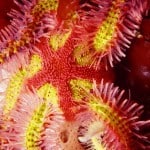 Diving the southern rigs such as Elly, Ellen & Eureka doesn’t require any special permission like the northern rig Grace did. One thing for sure is that you are probably much better off going with a charter boat or group like Channel Islands Dive Adventures that has experience doing rig trips. Anchoring is impractical due to depth and not an
Diving the southern rigs such as Elly, Ellen & Eureka doesn’t require any special permission like the northern rig Grace did. One thing for sure is that you are probably much better off going with a charter boat or group like Channel Islands Dive Adventures that has experience doing rig trips. Anchoring is impractical due to depth and not an  option, and tying off to the rig is prohibited therefore, live-boating is essential.
option, and tying off to the rig is prohibited therefore, live-boating is essential.
The normal routine is to have all the divers geared up, ready to go, and gathered on the bow of the boat or at the side gates waiting for the crew’s instructions. The captain maneuvers the boat as close to the structure as possible puts the engines in neutral and one by one the divers jump in after instructed to do so. Once in the water, they swim towards and into the rig and then descend for their dive.
When the divers are done with their dive they are instructed to stay close to the rig and NEVER swimming out towards the boat until told to do so. The captain again maneuvers the boat as close to the structure as possible and puts the engines in neutral. Next, the divers are instructed to swim to the boat to be picked up, usually in small groups. This is repeated until everyone is safely on board. Sometimes there is current and surge making all this a little more difficult and that is why it is an advanced dive.
Surge is common. Visibility can be 10 feet one day, 100 the next, with 40 to 60 feet the average. Currents, too, can be from light to very strong making it very important to stay under the platform for the dive. Only leave that area at the 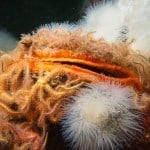 surface when your dive is finished and the boat’s crew signals you to come to the boat. If there is current you can always shelter behind the legs and cross braces. You must pay attention to safety procedures for entries, exits, and underwater
surface when your dive is finished and the boat’s crew signals you to come to the boat. If there is current you can always shelter behind the legs and cross braces. You must pay attention to safety procedures for entries, exits, and underwater 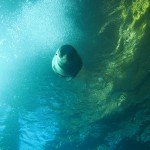 navigation. Orientation is mostly visual because with all the metal your compass will most likely be useless.
navigation. Orientation is mostly visual because with all the metal your compass will most likely be useless.
Oil platforms are busy, privately owned workstations and you must always be watching and listening for crew boats coming and going. For recreational divers, some of the best marine life usually is found from around 40’ to about 100’ feet. Techies can push 200-feet-plus on the rigs and they have many stories about the large Metridiums (white plumose anemones) at the deeper depths and how the water gets clearer at around 150’. The rigs are an excellent dive for photographers and sightseers and can be dived year-round!
Diving the Oil Rigs-an awesome experience-video courtesy of Ken Kollwitz
Oil Rig Eureka-SoCal Shootout 2014-Video courtesy of Ken Kollwitz
**All info updated on January 1, 2019
